Facts
The performance of any Tubular Daylight System (TDS) is governed by a number of factors. These can be separated into two categories; product specification and the building specification.
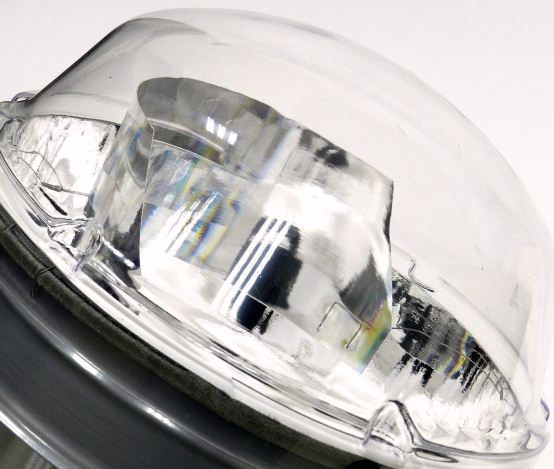 Taking the latter first, this will be the dictated by the building design and location. The length of the tubes and the orientation of the domes on the roof will all affect the performance of the daylighting systems in the building and are usually restrictions that can not be changed.
Taking the latter first, this will be the dictated by the building design and location. The length of the tubes and the orientation of the domes on the roof will all affect the performance of the daylighting systems in the building and are usually restrictions that can not be changed.
The former however, will also have a huge affect on the amount of natural light delivered and this is where correct system specification is vital. In essence, the maximum light will be delivered from a short, wide TDS located on a bright aspect. Fine in a perfect world, but not always practical. That’s why it’s imperative for designers and specifiers to understand the differences between the various TDS systems available and which sizes are required to deliver the optimum daylight levels for their projects.
Up to 50% brighter than the next best system
All TDSs are not the same. For example, Solarspot is not the only system to employ a tube system with a reflective value of 99.7%, what is not made clear however, is the effect the dome design has on the amount of light entering the tube. In fact, some domes with moulded lenses are actually designed to restrict light entering the tube at midday. This is fine for areas that are blessed with an abundance of sunlight – the Mediterranean or California – but of little use to anyone designing or living in a building in the UK. It also has a similar effect on cloudy days, actually blocking light into the system.
That is why Solarspot® systems employ a clear dome with a Fresnel RIR® Light Funnel located in the mouth of the tube. This innovative and unique solution ensures that the maximum amount of low-level light is harvested, capturing light on north-facing roofs, whilst providing a clear path for maximum delivery of over-head light – either direct sunlight or over-cast daylight. Couple these exclusive dome technologies with Solarspot’s Vegalux® super-reflective tubing and performance figures of up to 50% better than those of the best other rigid systems are easily achievable.
These patented technologies are standard across the complete Solarspot range of products from the compact D-25 system right up to the impressive D-90 unit.
SOLARSPOT® RIR® – LIGHT FUNNEL
Here’s how it works
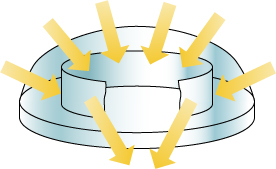 Solarspot’s RIR® Light Funnel uses prism technology to affect the path of light that enters the dome on the roof. The ultra- fine Fresnel prismic lens is suspended in the opening of the tube to refract (bend) low-level light down into the system rather than letting it pass straight out the other side of the dome. This is particularly noticeable at the beginning and of the day when the sun is lower in the sky. It can also provide an invaluable boost to the performance of a system by increasing the levels of natural light delivered during winter months.
Solarspot’s RIR® Light Funnel uses prism technology to affect the path of light that enters the dome on the roof. The ultra- fine Fresnel prismic lens is suspended in the opening of the tube to refract (bend) low-level light down into the system rather than letting it pass straight out the other side of the dome. This is particularly noticeable at the beginning and of the day when the sun is lower in the sky. It can also provide an invaluable boost to the performance of a system by increasing the levels of natural light delivered during winter months.
Another area where the RIR® system is on-hand to significantly increase light delivery is on north-facing roofs. In this situation, where the tube opening is always in shadow, the RIR Light Funnel system is able to capture sunlight that shines across the roof and refract it down into the tube.
How does the Solarspot dome compare to other systems?
Solarspot are not the only company to use Fresnel lens technology in an effort to maximise daylight capture. Some other manufacturers use Fresnel lenses in their systems, however these are moulded into the dome itself rather than locating the lens inside the tube mouth as on the Solarspot. And this is where the big difference in daylight harvesting occurs.
When the lens is combined with the dome it not only acts as a refractor but also works as a reflector – sending light away from the tube rather than directing it in. In fact, the lens is actually designed to restrict light from entering the system at certain points in the day. This is fine if you’re located in California where bright sunlight is there in abundance but not what’s required for us in the UK.
To sum it up; the crystal-clear dome and RIR® Light Funnel in the Solarspot system will significantly increase the amount of light entering the top of the tube, ensuring that more daylight is delivered to your room than with any other system.
SOLARSPOT® DOME
Advanced dome technologies for maximum light capture
The amount of light you get out from a light pipe is proportionate to the amount of light that goes in. That’s why Solarspot® Tubular Daylighting Systems employ light harvesting technology to ensure that as much of the available light enters the pipe as possible. This is particularly important on roofs that don’t face south. RIR® Fresnel lens technologies ensure that 360° light capture takes place, regardless of the location of the unit on the roof.
Solarspot roof domes are vacuum-formed from impact-resistant, crystal clear acrylic to guarantee maximum light transmittance. The unique dome geometry maximizes light collection while providing a maintenance-free surface that is cleansed by the elements. Our polycarbonate condensation lens, located just below the lens ensures the system meets UK fire regulations.
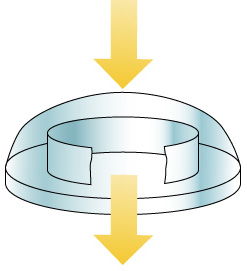 Solarspot® Dome
Solarspot® Dome
Solarspot® domes are engineered to minimise unnecessary surface area to avoid ‘solar-bounce’ (valuable light being lost through reflectance off the dome surface) so that the maximum amount of light enters the dome.
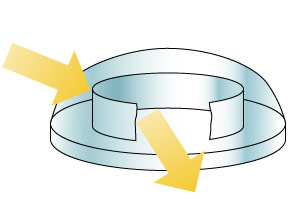 RIR® light capture system
RIR® light capture system
We also employ a suspended Fresnel lens refractor system, RIR® ‘light funnel’ to redirect light, as it enters the dome from lower angles, to direct it down into the tube.
In real terms, this could mean as much as twice as much light entering the top of the tube than on any other system.
 Avoid domes with moulded lenses
Avoid domes with moulded lenses
On a dome with integrated lens a significant amount of light is stopped by the lens itself. The lens is designed to even out light throughout the day, actually blocking out midday light – fine if you live in a sunny country but not suitable for the UK.
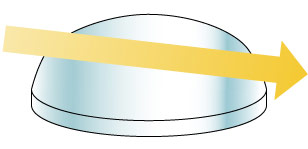 Standard clear dome – non-Solarspot®
Standard clear dome – non-Solarspot®
On an ordinary dome with no RIR Light Funnel system, low-level light just passes straight through the dome and not down into the tube.
VEGALUX® – ADVANCED LIGHT DELIVERY TECHNOLOGY
 Flexible-duct systems would be delivering around 10% of original light – losing over 90%.
Flexible-duct systems would be delivering around 10% of original light – losing over 90%.
All of this may sound complicated but it’s actually quite simple; every time light bounces off a surface it loses energy (light).
For example, if the light has to bounce 20 times to get from one end of the tube to the other then it will lose energy every bounce. With Vegalux® only 0.3% of the energy is lost on each bounce. The next best material, at 98%, will lose 2% each bounce. Over twenty bounces, that really adds up.
The illustration shows how the different materials deliver very different levels of light.
Vegalux extension tubes are available in a variety of lengths from 200mm to 1.2m. In addition, we produce a range of angle adapters to ensure a hassle free installation.
BEWARE THE FLEXIBLE FIEND!
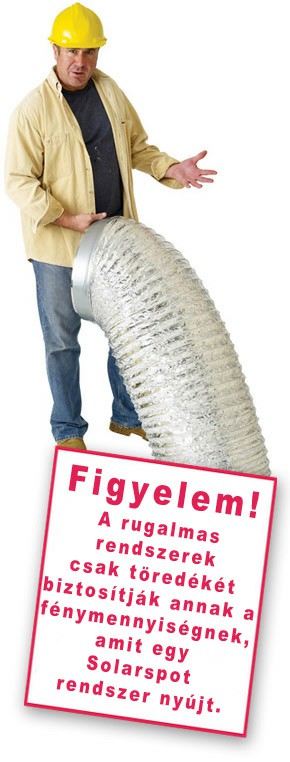 When choosing a Tubular Daylight System (TDS) you will find a number of different suppliers of systems. These systems fall into two different categories; rigid and flexible. Rigid systems, such as Solarspot®, use hi-tech, highly reflective (in our case Vegalux® 99.7% – the most reflective material in the world) to transfer the light – flexible systems use a foil air-conditioning style ducting to try and perform the same task.
When choosing a Tubular Daylight System (TDS) you will find a number of different suppliers of systems. These systems fall into two different categories; rigid and flexible. Rigid systems, such as Solarspot®, use hi-tech, highly reflective (in our case Vegalux® 99.7% – the most reflective material in the world) to transfer the light – flexible systems use a foil air-conditioning style ducting to try and perform the same task.
So how do you choose which system to buy and what difference will it make to you or the amount of natural light that you will get into your home?
The answer is simple. A Solarspot® TDS will transfer at least 10 times more light than a flexible system (in a typical installation). But don’t take our word for it. In recent tests carried out by the Building Research Establishment (BRE) systems, a TDS with a reflective value of more that 99% – very close to the specular reflectivity (99.7%) of our Vegalux material – was shown to out-perform the best flexible systems by around 10 times. The tests were based on the system being located on a south facing roof. If your were to consider the difference when location on a north, east or west facing roof, a SolarSpot® D-38 TDS could be delivering around 10 times more light and potentially a lot more*.
So why does anyone buy a flexible system? Well the simple answer is that they are cheap. However, when it comes to installation, the cost is the same. So when you consider that to achieve the same light levels as one Solarspot TDS you’d need at least 10 flexible systems it’s immediately apparent that the Solarspot is the best value solution.
* depending on time of day
The BRE test results are in
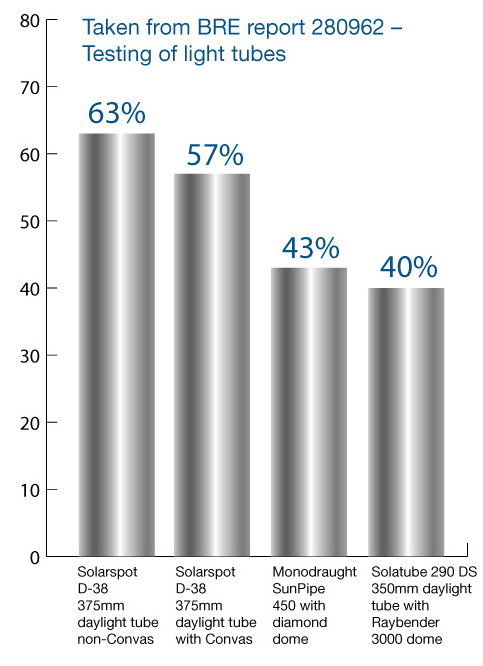
Compare the efficiency
Read the test report in full
Look at any sun tunnel suppliers’ website and they will probably tell you that their system is the best, the brightest, the most efficient etc. in order to persuade you to buy from them. So how do you know who’s telling you the truth and who’s leaving you in the dark when it comes to the facts?
To say that some manufacturers make claims that are open to interpretation is giving them the benefit of the doubt. A less charitable person might reach the conclusion that they are giving out false and misleading information. A couple of manufactures, who will remain nameless, are claiming to be ‘95% efficient’, when what they actually are is 95% reflective – not the same thing and the net result in terms of light delivery is massive. In fact, no system in the world is 95% efficient and systems with reflective values of only 95% are actually so poor that we discounted them in these tests.
It’s difficult for the average consumer to cut through all of the jargon and reach an educated and informed decision without the help of a qualified team of daylight boffins – and where can you find one of those when you need one? So in order to shed some light on the problem, we went to the independent daylight experts at the BRE and asked them for help.
The test results and what it means to you
Each system was tested three times to ensure that there were no spikes in light or freak results and the average of the efficiency of the three readings is given as the result.
As the table shows very clearly, the clear winner in efficiency terms is the Solarspot D-38 with results that are roughly half as good again as the other two. So what does that mean in terms of light delivery for you and your home.
Simply put, if you had two systems, side-by-side, in the same roof, facing in the same direction, and both tubes are the same length, then if one was half as efficient again as the other, then you would expect half as much light again as the other. But you also need to take into account the width of the tube.
For example; if you put a Solarspot D-38 and Solatube 290DS together – as suggested above – because the Solatube is 30 mm narrower, it has less volume. In turn, the Solarspot would be delivering around 69% more light in the same conditions.
Building Research Establishment
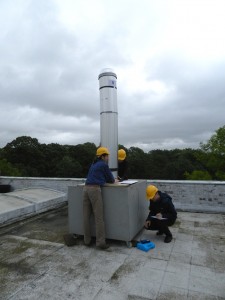 BRE (Building Research Establishment) is an independent and impartial, research-based consultancy, testing and training organisation, offering expertise in every aspect of the built environment and associated industries – that’s what it says on their website so who are we to argue.
BRE (Building Research Establishment) is an independent and impartial, research-based consultancy, testing and training organisation, offering expertise in every aspect of the built environment and associated industries – that’s what it says on their website so who are we to argue.
We asked them to take our Solarspot D-38 system and compare it to a Solatube 290DS and Sunpipe 450 and test them to see which was the most efficient at delivering daylight – what other reason would you have to buy one and what critical information would you need when deciding which system to purchase? We also referenced a couple of the very popular (amongst builders and not necessarily the individual left with the rather poor results – more will be explained) flexible duct systems.
So why these systems and sizes?
There are many systems and sizes available and it would be impractical, and expensive, to test every single system and size on the market, so we picked the countries best-selling rigid system; the Sunpipe from Monodraught and the Solatube, apparently the world’s leading daylight system. The Sunpipe system has a diameter of 450mm and has a claimed reflective value of 98% whilst the Solatube has a diameter of 350mm and reflective value of 99.7%, so the Solarspot sits in between size wise.
All three systems were just over 2m long and the tests were carried out under a natural overcast sky – this is Britain after all. The tests were performed at the BRE’s headquarters in Bricket Wood in Hertfordshire.
Flexible-duct systems
In tests previously carried out by the BRE for Solalighting Limited, (BRE test number 248038a) measuring the efficiency of two 350mm diameter flexible-duct systems, they were shown to be more flexible fiend rather than flexible friend (you have to be old enough to remember that reference).
The best figures that the flexible unit were able to return were only around 6%. This was with the ducting being pulled tight and with the tube completely straight. In reality the tube will not be totally straight and with some slack in the system; given this more realistic scenario the figures are likely to be nearer 1.5%-3%.
In conclusion
It’s clear to see that there is a resounding winner, and we hope that the winner is our customers. If you would like to read the full report from the BRE you can download it from our website, just follow the link at the top of the page.
If you would like more information about how Solarspot can transform your home with natural daylight, please call us today on 01908 299117 or use our email link.
SYSTEM SPECIFICATIONS AS TESTED
| Solarspot®D-38* | 375mm diameter, clear dome with RIR Light Funnel, single-glazed diffuser, Vegalux tubing; 99.7% reflectivity, 2280mm in length |
| Solarspot®D-38** | 375mm diameter, clear double-glazed dome with RIR Light Funnel and additional Convas lens, single-glazed diffuser, Vegalux tubing; 99.7% reflectivity, 2280mm in length |
| Solatube®290DS | 350mm diameter, Raybender dome with Light Tracker reflector, double-glazed diffuser, Spectralight tubing; 99.7% reflectivity, 2280mm in length |
| SunPipe®450 | 450mm diameter, diamond dome, double-glazed diffuser, Supersilver tubing; 98% reflectivity, 2280mm in length |
* This system is available on special order only and is subject to 28 days delivery.
** Convas lens is supplied as standard to provide maximum protection against condensation and improved thermal performance.



